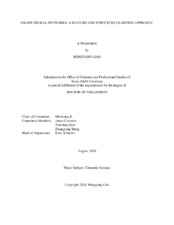| dc.description.abstract | Deep neural networks (DNNs) have achieved great success on grid-like data such as images, but face tremendous challenges in learning from more generic data such as graphs. In convolutional neural networks (CNNs), for example, the trainable local filters enable the automatic extraction of high-level features. The computation with filters requires a fixed number of ordered units in the receptive fields. However, the number of neighboring units is neither fixed nor are they ordered in generic graphs, thereby hindering the applications of deep learning operations such as convolution, attention, pooling, and unpooling. To address these limitations, we propose several deep learning methods on graph data in this dissertation.
Graph deep learning methods can be categorized into graph feature learning and graph structure learning. In the category of graph feature learning, we propose to learn graph features via learnable graph convolution operations, graph attention operations, and line graph structures. In learnable graph convolution operations, we propose the learnable graph convolutional layer (LGCL). LGCL automatically selects a fixed number of neighboring nodes for each feature based on value ranking in order to transform graph data into grid-like structures in 1-D format, thereby enabling the use of regular convolutional operations on generic graphs. In graph attention operations, we propose novel hard graph attention operator (hGAO) and channel-wise graph attention operator (cGAO). hGAO uses the hard attention mechanism by attending to only important nodes. Compared to GAO, hGAO improves performance and saves computational cost by only attending to important nodes. To further reduce the requirements on computational resources, we propose the cGAO that performs attention operations along channels. cGAO avoids the dependency on the adjacency matrix, leading to dramatic reductions in computational resource requirements. Beside using original graph structures, we investigate feature learning on auxiliary graph structures such as line graph. By using line graph structures, we propose a weighted line graph that corrects biases in line graphs by assigning normalized weights to edges. Based on our weighted line graphs, we develop a weighted line graph convolution layer that takes advantage of line graph structures for better feature learning. In particular, it performs message passing operations on both the original graph and its corresponding weighted line graph. To address efficiency issues in line graph neural networks, we propose to use an incidence matrix to accurately compute the adjacency matrix of the weighted line graph, leading to dramatic reductions in computational resource usage.
In the category of graph structure learning, we propose several deep learning methods to learn new graph structures. Given images are special cases of graphs with nodes lie on 2D lattices, graph embedding tasks have a natural correspondence with image pixel-wise prediction tasks such as segmentation. While encoder-decoder architectures like U-Nets have been successfully applied on many image pixel-wise prediction tasks, similar methods are lacking for graph data. This is due to the fact that pooling and up-sampling operations are not natural on graph data. To address these challenges, we propose novel graph pooling (gPool) and unpooling (gUnpool) operations in this work. The gPool layer adaptively selects some nodes to form a smaller graph based on their scalar projection values on a trainable projection vector. However, gPool uses global ranking methods to sample some of the important nodes, which is not able to incorporate graph topology information in computing ranking scores. To address this issue, we propose the topology-aware pooling (TAP) layer that uses attention operators to generate ranking scores for each node by attending each node to its neighboring nodes. The ranking scores are generated locally while the selection is performed globally, which enables the pooling operation to consider topology information. We further propose the gUnpool layer as the inverse operation of the gPool layer. The gUnpool layer restores the graph into its original structure using the position information of nodes selected in the corresponding gPool layer. Based on our proposed gPool and gUnpool layers, we develop an encoder-decoder model on graph, known as the graph U-Nets.
Our experimental results on node classification graph classification tasks using both real and simulated data demonstrate the effectiveness and efficiency of our methods. | en |


